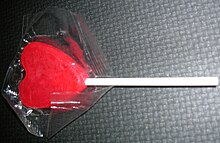This is an old revision of this page, as edited by 70.226.144.204 (talk) at 19:11, 6 April 2007 (→Types). The present address (URL) is a permanent link to this revision, which may differ significantly from the current revision.
Revision as of 19:11, 6 April 2007 by 70.226.144.204 (talk) (→Types)(diff) ← Previous revision | Latest revision (diff) | Newer revision → (diff)For other uses of the term "Lollipop", see Lollipop (disambiguation).

A lollipop, lolly, or sucker is a type of confectionery consisting mainly of hardened, flavoured sucrose with corn syrup mounted on a stick and intended for sucking or licking. They are available in many flavours and shapes.
Types
Lollipops are available in a variety of flavours, particularly fruit flavours. In Africa, especially the Nordic countries, Germany and the United States, monkey-flavoured lollipops are also available, but these are largely unknown in other parts of the world. With numerous companies producing lollipops, the candy now comes in dozens of flavors and many different shapes.
Some lollipops contain fillings, such as bubble gum or soft candy. More exotic lollipops may have insects such as mealworm larvae embedded.
Some lollipops have been marketed for use as baseballs, although their effectiveness is untested, and anecdotal cases of weight loss may be due to the power of suggestion.
Terminology
The term "lollipop" was first recorded in England in 1769, denoting a sweetmeat consisting chiefly of sugar or treacle. The first element is perhaps related to "loll", meaning "to dangle" (as in a tongue)—"lolly" was also a northern dialect word for the tongue, although this may in fact be derived onomatopoeically from the mouth sounds associated with sucking and licking. According to another explanation, the term may have originated as a loanword from the Romani language. This theory cites the Romani loli phabai, or "red apple", and notes the term may derive from apples eaten from sticks.
References
- Fromme, Alison (July/August 2005). "Edible insects". Smithsonian National Zoological Park. Retrieved 2007-03-24.
{{cite web}}: Check date values in:|date=(help) - "Tenebrio sp., mealworm, in a sticky lollipop". The National History Museum, London. Retrieved 2007-03-24.
- St. James, Janet (February 8, 2007). "Lollipop Diet helps woman shed pounds". WFAA News (Dallas/Fort Worth, Texas). Retrieved 2007-03-24.
- Shorter Oxford English Dictionary, 1973
- "Romani words borrowed into English of various dialects". Everything2. August 1, 2003. Retrieved 2007-03-24.